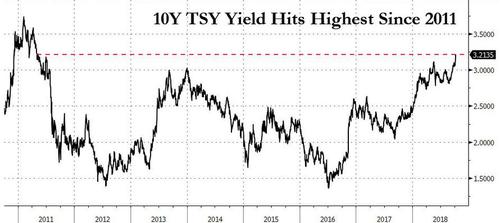US Treasury Yields Hit Seven Year High; Rising Interest Rates Could Be Bad News in Debt-Ridden Economy
by Peter Schiff, Schiff Gold:

Interest rates are climbing quickly.
The yield on the 10-year US Treasury hit the highest level since 2011 in the midst of a massive bond sell-off Wednesday. The selloff spread across the globe on Thursday morning. ZeroHedge called the spike in yields a “monster move.”
The 10-year US Treasury yield jumped 11 basis points on Wednesday to 3.16%. In European trading, the yield on the 10-year went as high as 3.2192%. The selloff was “promoted by stronger than expected US economic data, and which accelerated after upbeat, hawkish comments from Fed Chair Jerome Powell.”

Meanwhile, global stock markets took a big hit Thursday morning. Investors were greeted with a sea of red.
ZeroHedge said the selloff took traders by surprise with both its velocity and magnitude.
The sharp steepening in the Treasury curve, and the continued climb in yields spread like wildfire across the globe, pushing European and Asian yields higher while shares in emerging markets slipped.”
Pepperstone Group head of research Chris Weston said, “It’s a very rare occurrence to see US Treasuries undergo such a huge move.”
Most of the mainstream analysis emphasized the strength of the US economy and the expectation of more Federal Reserve tightening. They seem to be ignoring the darker side of this phenomenon.
Bond yields (interest rates paid) rise as the price of bonds falls. When there is a glut of bonds in the marketplace, you will see rising yields and falling prices as a function of supply and demand. There is already a huge supply of bonds as the US tries to finance its massive deficits.
Earlier this year, we asked the question: who is going to buy all of this US debt? The US Treasury Department plans to auction off around $1.4 trillion in Treasuries in 2018 alone. And it won’t end there. The department expects that pace of borrowing to continue over the next several years. That’s a lot of bonds. Who will buy them?
The three biggest buyers aren’t in the market. Both the Chinese and Japanese have been selling US debt. The Federal Reserve has embarked on quantitative tightening, so it is shedding bonds from its balance sheet. With these big boys out of the market, it appears we could already be seeing a Treasury glut. That means interest rates will likely rise even further. That’s not good news in an economy built on piles of debt.
As the Sovereign Man has pointed out, higher interest rates will have an enormous impact on just about everything.
Many major asset prices tend to fall when interest rates rise. Rising rates mean that it costs more money for companies to borrow, reducing their leverage and overall profitability. So stock prices typically fall. It’s also important to note that, over the last several years when interest rates were basically ZERO, companies borrowed vast sums of money at almost no cost to buy back their own stock. They were essentially using record low interest rates to artificially inflate their share prices. Those days are rapidly coming to an end.”
Not to mention the cost of servicing the massive US federal debt.
Rising interest rates could also serve as the pin that pricks the stock market bubble.
“This withdrawal of liquidity and gradual tightening of monetary policy” is reverberating across financial markets according to Bob Baur, chief global economist at Principal Global Investors “We look for 10-year Treasury yields to hit 3.5% at some point – later this year, early next year – and I think that’s going to be a real problem for stock markets.”
Loading...



